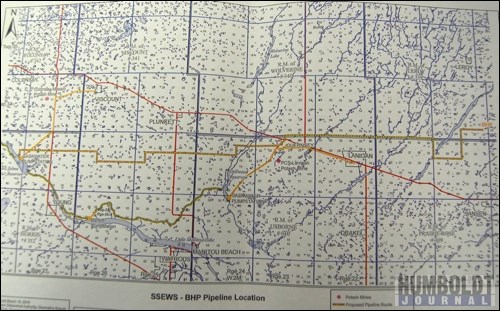A new potash mine in the LeRoy-Jansen area has drawn a lot of attention, but one particular aspect of the development was highlighted at a public meeting last week.
On December 7, the Lanigan-Manitou Watershed Advisory Committee (LMWAC) held a public consultation meeting on the water supply for the proposed mine.
According to Timo Jansen of SaskWater, BHP Billiton approached SaskWater in 2008 with a request for a proposal for a guaranteed water supply, approximately 190,000 imperial gallons per year, for their mine.
After some study by the Saskatchewan Watershed Authority (SWA), it was decided that the Saskatoon South-East Water Supply system had enough water to fulfill the BHP request.
"A review by the SWA showed the Zelma Reservoir to be the most suitable source for the water supply," explained Jansen. "It needs minor modifications to the canal capacity and a new intake structure in the reservoir, along with the construction of a new pipeline."
SaskWater then hired AECOM and Rescan Environmental Services to provide consulting services on the environmental impact and construction of the pipeline and associated infrastructure.
Rescan developed an environmental impact study on a six-mile corridor that the proposed pipeline could take between the Zelma Reservoir and the proposed BHP mine site, explained jansen. That study included baseline studies on the water quality in the reservoir, fish habitat, wildlife habitat, wet lands, soils, vegetation mapping, and heritage resources, explained Jason Rempel of Rescan.
Rescan came up with three recommendations to maintain the reservoir. These included increasing the full supply level of the reservoir by .34 metres, running the canal collection system that leads water into the reservoir for one more week in the spring and in the fall, and installing a new pump station at the north end of the lake, where the water is deepest.
Right now, there are four possible route options for the 94-kilometre pipeline, Rempel noted. They all follow existing road allowances which will minimize land disturbance and make inspection and maintenance easier.
The current favourite option crosses creeks, highways, and natural gas lines, Rempel noted.
A detailed project proposal was submitted to the provincial Ministry of Environment in October and is being reviewed by the province, he added.
AECOM started looking at the route and the engineering from a construction perspective in July, explained Ryan Cadieux with AECOM. The company has developed a conceptual design that they recently presented to SaskWater, which included what the pipeline will look like in size and design, he said.
The next step is a preliminary design report which will define the details of the system. That report should be finished by the end of March. If it is approved, AECOM will proceed to a detailed design with the specifications of the system which will be used in the tendering process.
The proposed route of the pipeline will cross five CN crossings; five highway crossings - at Hwys. 2, 16, 20, 365, 667; six creeks and streams, 11 wetlands, and seven high pressure TransGas lines, Cadieux said.
All those crossings represent a significant component of any plan to design and build the pipeline, he noted.
As well, the size of pipe and material used in the pipeline will be considered.
Water will flow through the pipeline at 3,600 to 5,300 imperial gallons per minutes, he said. Maintaining those pressures requires the construction of a booster station somewhere along the line. Right now, the plan has the station located just north of Lanigan.
Questions from the nearly 50 people at the meeting covered cost, timelines, and capacity.
BHP is paying all the costs of the pipeline, including studies, design and construction, explained Jansen.
"This project is not taxpayer-funded," he stated.
BHP will give SaskWater a final decision on whether to build the pipeline in late 2011, Jansen said. If the project goes ahead, it will go to tender in early 2012, with construction starting the same summer and work will be completed by the summer of 2014, he explained.
The project will cost close to $120 million, Jansen noted.
SaskWater saw the meeting as an opportunity to get people aware of what's going on," Jansen said. "This will be a positive economic development and a potential benefit to communities in the area."
The water in the pipeline will not be potable.




